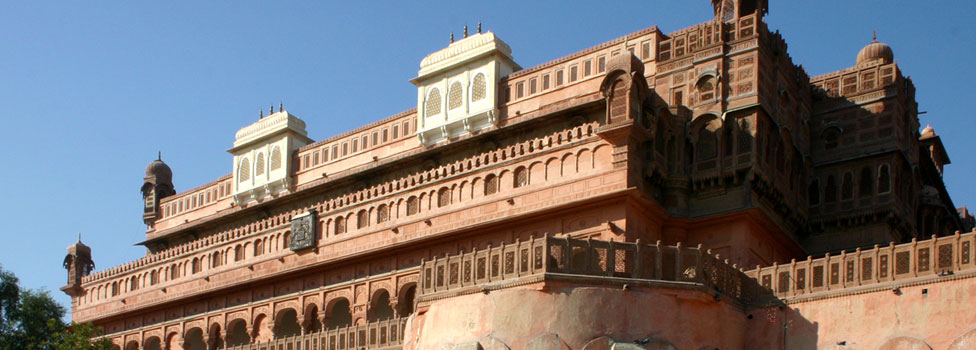Constructed between 1587 and 1593 by the third ruler of Bikaner, Rai Singh, Junagarh Fort is protected by a 986 m long sandstone wall with 37 bastions, a moat and, most effectively of all, by the forbidding expanse of the Thar Desert. Not surprisingly, the fort has never been conquered, a fact which explains its excellent state of preservation.
Exploring the Junagarh Fort, Bikaner
Within the fort’s austere stone walls are no less than 37 profusely decorated palaces, temples and pavilions, built by its successive rulers over the centuries, though in a harmonious continuity of style. The most outstanding is the Anup Mahal, built by Maharaja Anup Singh in 1690 as his Hall of Private Audience. It was sumptuously decorated between 1787 and 1800 by Maharaja Surat Singh. In an ingenious imitation of Mughal pietra dura work at a fraction of the cost, the lime-plaster walls of the Anup Mahal have been polished to a high luster. They are covered with red and gold lacquer patterns, further embellished with mirrors and gold leaf. The Karan Mahal is the Hall of Public Audience and is ornamented in a similar if somewhat less lavish style. Two other gorgeous, heavily decorated palaces are the 17th century Chandra Mahal and Phool Mahal. The latter contains Rao Bika’s small, low bed with curved silver legs, on which he slept with his feet touching the ground. The bed was so designed to enable Rao Bika to jump quickly to his feet and fight off murderous intruders. The Chandra Mahal, which was the queens’ palace, has carved marble panels depicting the Radha-Krishna legend, and both palaces have superb stone carving and jalis. The blue-and-gold Badal Mahal is covered with paintings of clouds, yellow streaks of lightning and rain showers – a favorite fantasy in this arid land. The Hawa Mahal has a huge mirror positioned over the maharaja’s bed, which apparently enable him to view the courtyard below, thus alerting him to approaching danger. The oldest palace in the fort is Lal Niwas, dating to 1595, and decorated with floral motifs in red and gold.
How to reach Junagarh Fort, Bikaner
By Air
Nearest airport is Jodhpur, connected by daily flights to Jaipur, Delhi, Udaipur and Mumbai.
By Rail
Bikaner Junction is well-connected to Delhi by the Bikaner Mail, to Mumbai by the Jammu Tawi and to Kolkata by the Howrah-Jodhpur Express. The Jaipur-Bikaner Intercity and Jaipur-Bikaner express trains are the best options to Jaipur. Both taxis and autos are easily available at the station.
By Road
Bikaner is at the western end of NH11 that links Agra to Jaipur. Travelers from Delhi should turn off NH8 at Kot Putli and take the road to Sikar via Nim ka Thana and Khandela. From here, take NH11 to Bikaner.
Junagarh Fort, Bikaner


